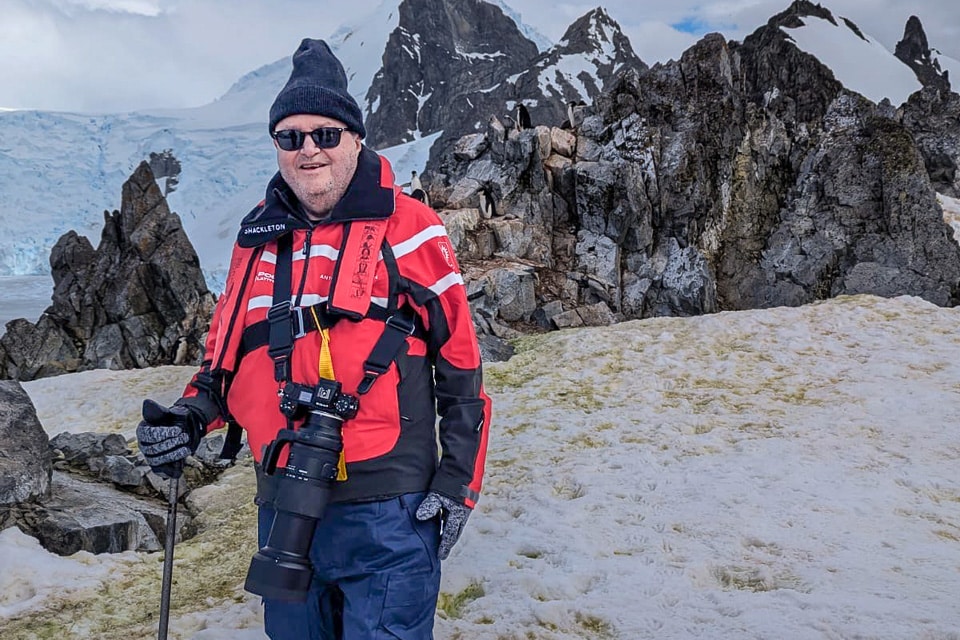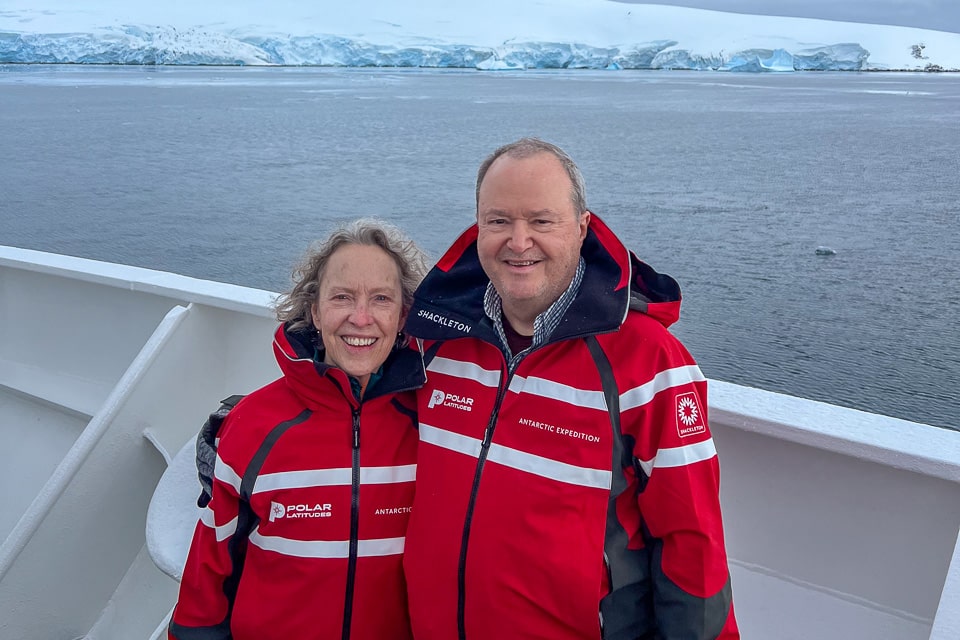
We admit we were complete novices when it comes to compiling an Antarctica cruise packing list. But with the help of our cruise company, Polar Latitudes, and some friends who've been there before, we packed our bags with plenty of warm gear.
We probably erred on the side of caution and took too much stuff, violating our own “pack as light as possible” mantra. Essentially, we took two of everything we needed, guarding against your only set of protective clothing getting too wet to wear again until it dried out. If you're being safe, that's probably not a terrible idea.
However, our personal experience now tells us you can get by with less. When we go next time, we'll be a bit more selective when we pack.
Read Kris's post all obout our expedition cruise to Antarctica.
Like nearly all group tours and adventure travel trips, this cruise to Antarctica requires you carry travel insurance. We're always ready to go with our Allianz Travel Insurance Annual Policy.
Table of Contents
What to Pack for an Antarctic Expedition Cruise
The first thing to remember is that it's likely your Antarctic cruise line will provide two items for your use: boots and a coat.
The boots will be sturdy calf-high waterproof boots. These rubber boots are called “muck” boots and you'll know why when you see your first penguin colony. (You'll return these at the end of the trip.) Use of the boots off ship is required, and they are scrubbed and disinfected every time you return to the ship.
You'll also more than likely get a waterproof and windproof outer shell jacket you'll get to keep. That's two essentials you won't have to bring with you. (But one you'll need room in your bag to get home.)
The second thing to remember is that you are going to Antarctica during the Antarctic summer, i.e. November-March, and the weather conditions on the Antarctic Peninsula are not bitter cold. While we were on our Antarctica trip in late January to early February, the temperatures varied from a few degrees above to a few degrees below freezing (25 to 35F, or -2 to +2C.) The coldest temperatures of the trip were actually on the passage from South America to Antarctica, where there is a lot of wind.
So while you won't need the heftiest parka you can imagine – you're not actually going to the South Pole – you will need enough thermal layers to keep you warm for several hours at a time. (One day, climbing up a big hill to photograph a colony of penguins, I actually got warm enough to unzip my outer jacket and under layer down vest.)
And, don't forget you probably will be doing shore visits by riding in a Zodiac, so waterproof gear is critical. More critical than warmth.
Finally, consider the length of your time in the polar region. We were in Antarctica for five days. If you're going for longer, adjust accordingly or be prepared to do a little laundry.
Under layers
- Wool socks. Take enough warm socks for a pair per day of your trip. We like a few brands of merino wool socks: Unbound Merino, Point6, and Darn Tough. Pick what works for you.
- Underlayer silk socks. Take my word for it, this very slim layer of silk socks is the best thing you can do for warmth and friction protection. Wear them under your heavier wool socks.
- Base layer bottoms. You want a long base layer for warmth. You can probably get away with one pair of thermal underwear, but, like I said, I took an extra pair.
- Base layer tops. This is where I love Unbound Merino. We each have several long-sleeve Unbound Merino undershirts. The added bonus to these is they don't absorb odor, so you can get away with fewer than you think. I took two for five days on Antarctica. Kris took two long-sleeve base layer tops and one short-sleeve, all Merino wool.
- Neck gaiter. This Buff neck gaiter is actually my daily neck wear for Minnesota winters as well. It keeps your neck warm, and you can easily pull it up completely over your head and face if you need extra protection there. And, it scrunches up tiny in your jacket pocket, if you get too warm.
- Stocking cap. If you live in a climate that has winter, like we do, you probably have four of these in a drawer somewhere already. If not, any of these stocking caps will do the trick. Women, forego pom-poms, as they can interfere with a hood.
- Light down vest. This or an alternate mid layer goes under your provided waterproof jacket. Again, because we're Minnesotans, we each have a couple of these light down vests. All things being equal, the REI brand is great. If you're worried about your arms getting cold, buy a long sleeved down “sweater”. If you have a nice wool sweater, that will work as well. As would a light fleece jacket.
Outer layer
As I said above, Polar Latitudes gave us very nice Shackleton waterproof shell jackets. Honestly, this jacket is probably the nicest jacket I've ever owned. Thanks again.
- Waterproof pants. After shopping for a pair of waterproof pants at our local REI multiple times and being frustrated at finding something that would work for under $200, I found these insulated snow pants on Amazon. In short, they were cheap, and worked great. Kris used some shell pants for her outer layer, more wind than waterproof, but not a problem since she had two of everything. Note that your outer pants must be wide enough to fit over the muck boots.
- Gloves. I took two versions of gloves. The ones in the picture above were Promaster knit photo gloves. They are kind of neat, because the index finger and thumb have tips that fold off so you can operate your camera easily. The downside to these was they were far from waterproof. So, they're great for once you get on land and want to use your camera, but once they're wet on the Zodiac ride, forget it. If you go this route, keep them in your jacket pocket until you get to dry land. A better solution is my serious pair of Dakine waterproof gloves that have two great features: one is that they have tethers you can attach to your wrist so you can take them off without dropping them or putting them in your pocket; and two, they have thin liners that are touch screen compatible once you take off the outer glove. Best of both worlds. If your hands are prone to cold, chemical hand warmers are not a bad idea, too.
Incidentals
- Dry bag. You will definitely want a waterproof bag – a roll-up dry bag – for anything you take on the Zodiac, because anything you take on the Zodiac will get wet. I got an Osprey backpack dry bag big enough for two cameras with long telephoto lenses.
- Camera equipment. Here is my camera gear. A longish zoom lens to photograph animals you can't get close to is a must. One tip for Antarctica that would have saved me some room: you don't need a tripod.
- Binoculars. We absolutely love our Athlon binoculars. Spectacular performance at a reasonable price.
- Phone lanyard. Definitely get a phone lanyard, especially if you're going to be shooting with it on your Zodiac rides. You really would be sorry to drop your phone off the Zodiac into the Southern Sea.
- Water bottle. Antarctica air is dry. You will be thirsty. I clipped mine to the outside of my dry bag. Whatever you do, don't put it inside your dry bag. A leaking water bottle in a dry bag once destroyed one of my cameras.
- Trekking poles. We advise against taking your sticks. These were provided by Polar Latitudes, and it's more convenient for them to disinfect all their poles at once when you return to the ship.
- Power bank and plug adapter. We like this auxiliary power bank and this universal plug adapter.
- Sunglasses, sunscreen and lip balm. The sun bouncing off the snow on sunny days in Antarctica is strong!
- Snacks. Toss a couple of power bars in your dry bag. You might want them if you're out for a few hours and doing a lot of walking. Hang on to your wrappers.
- A bathing suit for the polar plunge or the sauna on the ship.
- Motion sickness medicine. When you're on the Drake Passage, you'll probably want Dramamine at least. But you might want to ask your doctor for the prescription medication scopolomine patches. If you're queasy about strong medicine, try the Relief Band motion sickness wristband. I used it. It works.
Are you stopping somewhere on the way?
We stopped in Buenos Aires for five days on the way to Ushuaia, where we caught our Polar Latitudes cruise ship. Be sure to leave room in your suitcase for warm weather clothes for Buenos Aires. It was 85F (29C) while were there.
You can see my warm weather ultra light packing list for men here; and Kris's packing list for women here.
If you've been to Antarctica and want to suggest something we may have forgotten, please add it in the comments. Thanks.

If you haven't been to Antarctica, go. It's the experience of a lifetime.
Up Your Travel Skills
Looking to book your next trip? Use these resources that are tried and tested by us. First, to get our best travel tips, sign up for our email newsletter. Then, be sure to start your reading with our Resources Page where we highlight all the great travel companies and products that we trust. Travel Accessories: Check out our list of all the accessories we carry to make getting there and being there a lot easier. Credit Cards: See our detailed post on how to choose the right travel rewards credit card for you. Flights: Start finding the very best flight deals by subscribing to Thrifty Traveler. Book your Hotel: Find the best prices on hotels with Booking.com. See all of the gear and books we like in one place on our Amazon shop.Got a comment on this post? Join the conversation on Facebook, Instagram, or Threads and share your thoughts!


